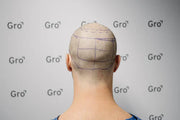
When losing your hair becomes a daily worry, the first response many people have is to run to their local chemist and throw away good money on a product that may not be suited to the actual hair loss type that they are suffering from. Before you start to address your hair loss with any form of treatment, it’s important to speak to a hair loss specialist first.
In this article, we discuss the various types of hair loss, what to look out for and how you can slow down, and in some cases even stop hair loss.
If you suffer from hair loss, answer these 3 questions to discover the best treatment option for you.
Types of Hair Loss
Androgenetic Alopecia
The most common form of hair loss, androgenetic alopecia affects roughly 50% of men and a large portion of women above the age of 40 years. The incidence of androgenetic alopecia increases greatly in women following menopause.
Alopecia Areata
Round or oval patches of hair loss on the scalp or in the eyebrows typically signifies alopecia areata. Those who develop this type of loss can progress to total scalp hair loss (alopecia totalis). The cause of alopecia areata is unknown, but it is thought to be an autoimmune disorder.
Telogen Effluvium
Telogen effluvium is a common type of hair loss caused when a large percentage of scalp hairs suddenly going into “shedding” phase. The causes of telogen effluvium may be hormonal, stress related, due to poor diet or drug-associated.
Trichotillomania
Trichotillomania is the name given to the habitual and compulsive plucking of hair from the scalp and/or other hair-bearing areas of the body. Long-term trichotillomania can result in permanent irrevocable damage. It remains unknown whether trichotillomania should be classified as a habit or as obsessive-compulsive behavior. In its mildest form, trichotillomania is a habitual plucking of hair while a person is doing a passive activity, such as reading or watching television. In its more severe forms, trichotillomania has a ritualistic pattern and the hair-plucking may be conducted in front of a mirror. The person with trichotillomania often has guilt feelings about his or her “odd” behavior and will attempt to conceal it. Hair loss due to trichotillomania is typically patchy, as compulsive hair pullers tend to concentrate the pulling in selected areas. Hair loss in this case cannot be treated effectively until the psychological or emotional reasons for trichotillomania have been addressed effectively.
Traction Alopecia
This type of loss is caused by chronic traction (pulling) on the hair follicle and is seen most commonly associated with tight braiding or cornrow hair styles. In most cases, this form of alopecia manifests itself along the hairline. Men who attach hairpieces to their existing hair can also experience this type of permanent loss if the hairpiece is attached in the same location over a long period of time.
Scarring Alopecia
Loss of hair due to scarring of the scalp is called scarring alopecia. Scarring can result from a number of causes such as injury or trauma to the scalp, burns and diseases. Diseases that may cause permanent loss due to scalp scarring include the autoimmune conditions; lupus erythematosus and scleroderma, and bacterial infections such as folliculitis, fungal infections, and viral infections such as shingles. Traction alopecia over a period of time may lead to scarring and permanent loss. Similarly, trichotillomania (compulsive hair-plucking) can cause permanent scalp scarring over time.
Triangular Alopecia
Triangular alopecia is loss of hair in the temporal areas that sometimes begins in childhood. Hair loss may be complete, or a few fine, thin diameter hairs may remain. The cause of triangular alopecia is not known, but the condition can be treated medically or non-surgically.
Loose Anagen Syndrome
Typically affecting fair-haired persons, loose anagen syndrome happens when scalp hairs sit loosely in the hair follicles so they can easily be extracted by combing or pulling. It appears in childhood but usually improves as the child ages.
What Can I Do About My Hair Loss?
If you have never received a formal diagnosis for your hair loss it’s important to see a Gro hair growth specialist to get a correct diagnosis and discuss your hair loss treatment options. Simply click on one of the buttons below to book a consultation or ask a question. Alternatively, you can give Gro a call on 1300 787 563.
For more information, you can visit a Gro clinic in Sydney, Brisbane or Melbourne, or Gold Coast or call 1300 787 563.
Related Article: 6 Reasons Why People Go Bald













